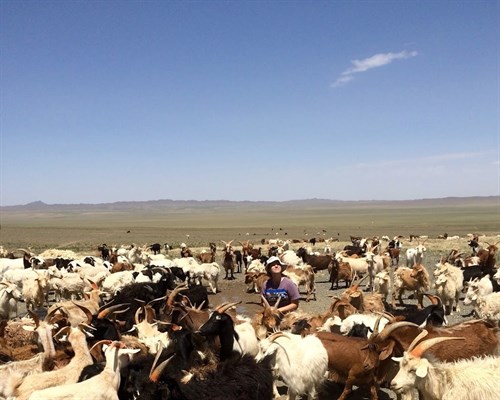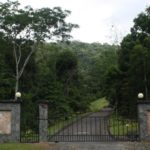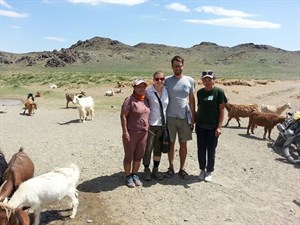 This summer I was given the unique opportunity to work alongside Wildlife Conservation Society (WCS) in efforts to promote sustainability of the cashmere system in the Southern Gobi Desert of Mongolia. I hoped that the experience would lead to a lot of new knowledge and opportunities. I expected to learn what it meant to work in rural veterinary medicine, get lots of hands-on work with cashmere goats, and perhaps improve language or cultural skills along the way. I gained all those things, and so much more. I could not have anticipated the profound effect the people would have on me.
This summer I was given the unique opportunity to work alongside Wildlife Conservation Society (WCS) in efforts to promote sustainability of the cashmere system in the Southern Gobi Desert of Mongolia. I hoped that the experience would lead to a lot of new knowledge and opportunities. I expected to learn what it meant to work in rural veterinary medicine, get lots of hands-on work with cashmere goats, and perhaps improve language or cultural skills along the way. I gained all those things, and so much more. I could not have anticipated the profound effect the people would have on me.
My main goal as a part of the WCS project was to gain insight on the overall cashmere goat health in the Ömnögovi province in southern Mongolia. This assignment allowed me to design my own methods for obtaining data in the field. I talked to various veterinary and research professionals about the ways to design a study and what would be the most efficient ways to collect the data. I finally decided on a set of physical exam protocols, and a questionnaire for each nomadic herder family. I was then paired up with a local veterinarian, a recent veterinary graduate with some English skill, and a driver. I knew there would be a language barrier, but as I began the data collection I found that I had so much more to learn.
Once in the field, a typical day was started with each family in their home, that some would call a Yurt, or Ger. The family always hospitable and kind, always giving us milk tea and cookies before any real conversation had begun. My recent veterinary graduate would ask the questionnaire as we shared our tea. The questionnaires included queries on whether farmers dewormed their goats, how much money they spent on them, and what health issues they observed in the herd. We would then all ride out together (us in our van, and the locals on their motorcycles) to the location of the herd. I then measured body condition score (BCS), recorded gender and age, used FAMACHA cards to score anemia, documented ectoparasites, and took fecal samples to analyze the fecal egg per gram counts. We met about four families a day and sampled at least twenty goats out of each of their herds. We would spend most of the afternoon setting up camp, reading fecal samples, and cooking a meal that would likely involve goat meat.
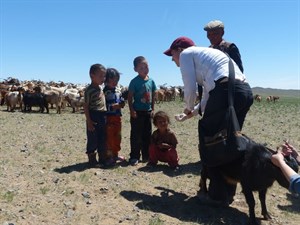 Through all this, I struggled to learn the language on fundamental level. Though my translator is someone I now consider a dear friend, at first the language learning curve was quite steep for both of us. She had never actually spoken English with a native speaker, and I knew little to no Mongolian. For the first time in my life I was in a situation where I had no means to express what I meant if misunderstood. My team and I learned some creative body language and started to understand each other more and more. About a week or two into our study, I sustained an injury that forced me to return to the city. That’s where I gained a new resource- a veterinary student from Utah with a statistics background.
Through all this, I struggled to learn the language on fundamental level. Though my translator is someone I now consider a dear friend, at first the language learning curve was quite steep for both of us. She had never actually spoken English with a native speaker, and I knew little to no Mongolian. For the first time in my life I was in a situation where I had no means to express what I meant if misunderstood. My team and I learned some creative body language and started to understand each other more and more. About a week or two into our study, I sustained an injury that forced me to return to the city. That’s where I gained a new resource- a veterinary student from Utah with a statistics background.
After I dealt with my health issues, our new team member took another look at the way we collected data. We re-worked our comments section and instead started scoring animals on their skin and hair, bloating, and stool quality. We then were able to use the statistical software R to analyze our data in the field, even running paired T tests to make sure that each observer was scoring on the same scale as the study went on. With this new insight, we were able to provide the project with a way to easily repeat this study every year as the project continues. Though we have just begun to analyze the data, it shows promise to be a very informative and helpful set of materials
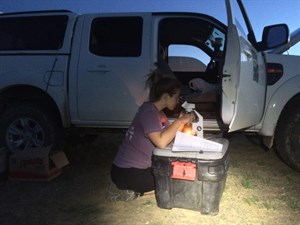 Though I learned a lot for my professional career, I also was able to meet families who shaped me as an individual. Each family in their Ger had one room where the family would eat, sleep, and play. They were always generous and helpful, even though I knew they had work to do to survive in the harsh desert environment that they lived in. They celebrated Naadam, a large cultural holiday, with me as if I was one of their own, and invited me to sleep in their Gers with them. The local veterinarians were humble, eager to learn, and proud to show me the Eastern medicine techniques they used such as bleeding their animals when sick. These families focused on people over materials, and hospitality over distrust. I hope to continue my relationships with those I met so that I continue to learn from them.
Though I learned a lot for my professional career, I also was able to meet families who shaped me as an individual. Each family in their Ger had one room where the family would eat, sleep, and play. They were always generous and helpful, even though I knew they had work to do to survive in the harsh desert environment that they lived in. They celebrated Naadam, a large cultural holiday, with me as if I was one of their own, and invited me to sleep in their Gers with them. The local veterinarians were humble, eager to learn, and proud to show me the Eastern medicine techniques they used such as bleeding their animals when sick. These families focused on people over materials, and hospitality over distrust. I hope to continue my relationships with those I met so that I continue to learn from them.
This entire trip was one filled with wonderful experiences, foreign challenges, and beautiful people. I feel so fortunate to have received the ISA stipend and a stipend from Texas A&M College of Veterinary Medicine’s International Program, without which this would not be financially possible. I now have a greater understanding of caprine veterinary medicine, Mongolian culture, and what it means to be focused on the things that truly matter in life. I feel that this trip has made me a better veterinary professional, but also a better person. I hope that everyone has the opportunity to see what it means to be a foreigner and learn what their true strengths are outside of their comfort zone.
